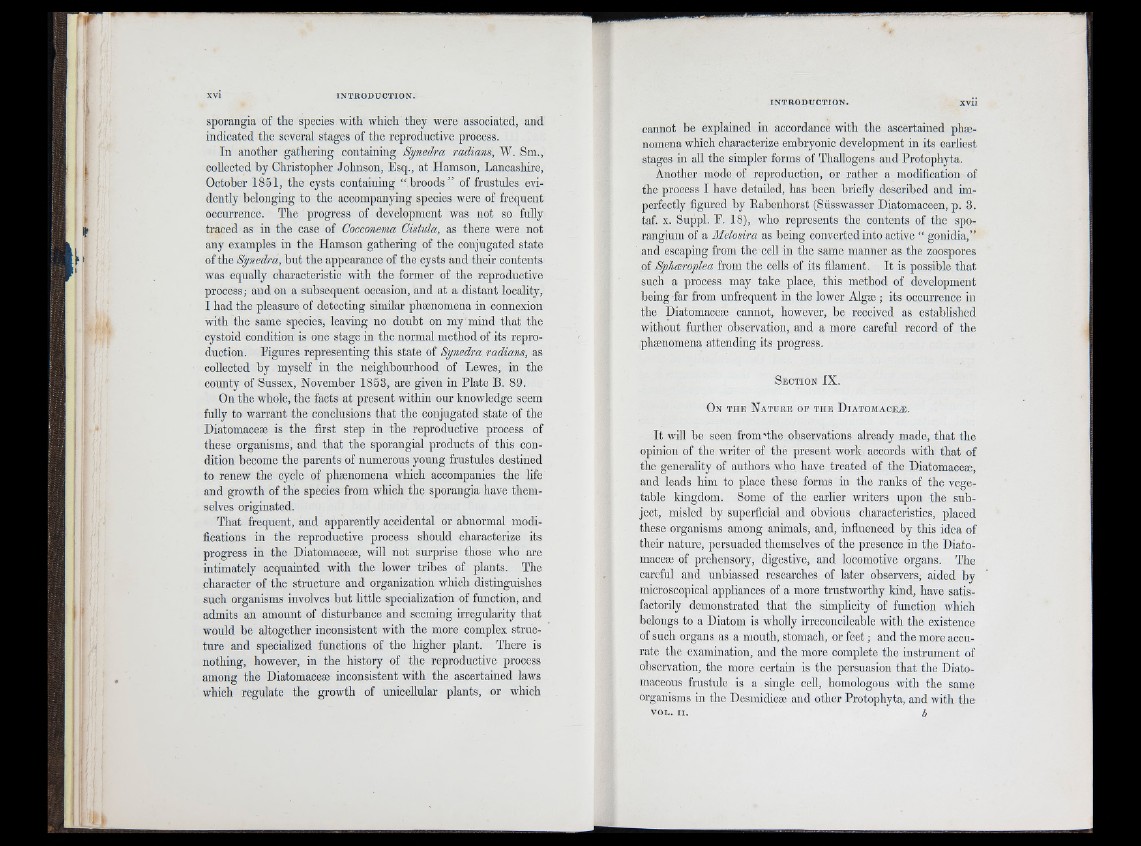
sporangia of the species with which they were associated, and
indicated the several stages of the reproductive process.
In another gathering containing Synedra radians, W. Srn.,
collected by Christopher Johnson, Esq., at Hamson, Lancashire,
October 1851, the cysts containing “ broods” of frustules evidently
belonging to the accompanying species were of frequent
occurrence. The progress of development was not so fully
traced as in the case of Cocconema Cistula, as there were not
any examples in the Hamson gathering of the conjugated state
of the Synedra, but the appearance of the cysts and their contents
was equally characteristic with the former of the reproductive
process; and on a subsequent occasion, and at a distant locality,
I had the pleasm-e of detecting similar phænomena in connexion
with the same species, leaving no doubt on my mind that the
cystoid condition is one stage in the normal method of its reproduction.
Eigures representing this state of Synedra radians, as
collected by myself in the neighbourhood of Lewes, in the
county of Sussex, November 1853, are given in Plate B. 89.
On the whole, the facts at present within our knowledge seem
fully to warrant the conclusions that the conjugated state of the
Diatomaceæ is the first step in the reproductive process of
these organisms, and that the sporangial products of this condition
become the parents of numerous young frustules destined
to renew the cycle of phænomena which accompanies the life
and growth of the species from which the sporangia have themselves
originated.
That frequent, and apparently accidental or abnormal modifications
in the reproductive process should characterize its
progress in the Diatomaceæ, will not surprise those who are
intimately acquainted with the lower tribes of plants. The
character of the structure and organization which distinguishes
such organisms involves but little specialization of function, and
admits an amount of disturbance and seeming irregularity that
would be altogether inconsistent with the more complex structure
and specialized functions of the higher plant. There is
nothing, however, in the history of the reproductive process
among the Diatomaceæ inconsistent with the ascertained laws
which regulate the growth of unicellular plants, or which
i n t r o d u c t i o n . x v i i
cannot be explained in accordance with the ascertained phæ-
nomena which characterize embryonic development in its earliest
stages in all the simpler forms of Thallogens and Protophyta.
Another mode of reproduction, or rather a modification of
the process I have detailed, has been briefly described and imperfectly
figured by Rabenhorst (Sfisswasser Diatomaceen, p. 3.
taf. X. Suppl. E. 18), who represents the contents of the sporangium
of a Melosira as being converted into active “ gonidia,”
and escaping from the cell in the same manner as the zoospores
of Spheeroplea from the cells of its filament. It is possible that
such a process may take place, this method of development
being far from unfrequent in the lower Algæ ; its occurrence in
the Diatomaceæ cannot, however, be received as established
without further observation, and a more careful record of the
phænomena attending its progress.
S e c t i o n IX.
On t h e N a tu r e of t h e D ia t o m a c eæ .
It will be seen from'the observations already made, that the
opinion of the writer of the present work accords with that of
the generality of authors who have treated of the Diatomaceæ,
and leads him to place these forms in the ranks of the vegetable
kingdom. Some of the earlier writers upon the subject,
misled by superficial and obvious characteristics, placed
these organisms among animals, and, influenced by this idea of
their nature, persuaded themselves of the presence in the Diatomaceæ
of prehensory, digestive, and locomotive organs. The
careful and unbiassed researches of later observers, aided by
microscopical appliances of a more trustworthy kind, have satisfactorily
demonstrated that the simplicity of function which
belongs to a Diatom is wholly irreconcileable with the existence
of such organs as a mouth, stomach, or feet ; and the more accurate
the examination, and the more complete the instrument of
observation, the more certain is the persuasion that the Diato-
maceous frustifie is a single cell, homologous with the same
organisms in the Desmidieæ and other Protophyta, and with the
VO L. I I . I)